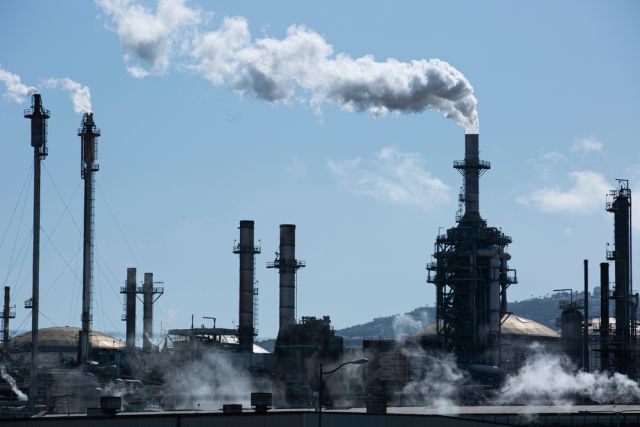
The EPA has set standards to lower emissions from high-emitting equipment, mandated monitoring of methane leaks from well sites and compressor stations and directed companies to eliminate routine flaring of natural gas produced by new oil wells. (Source: Shutterstock)
When it comes to mitigating methane amid a barrage of new federal rules, experts say having accurate data alongside technology are key to navigating the emissions reduction landscape.
Toolkits are equipped with optical gas imaging cameras and leak detection and repair (LDAR) equipment and services, as well as access to satellite detection and flyovers. But having systems in place to gather data about operational performance will make calculations easier, paving the way to improved business performance, according to Shankar Annamalai, senior vice president of Permian geo market and emissions technologies for ChampionX.
“Without the strong base of calculating, measuring, getting really good data around your operations, you can’t build on top of it,” Annamalai said during Hart Energy’s SUPER DUG Conference & Expo.
The words were shared as the oil and gas industry adjusts to operating under the U.S. Environmental Protection Agency’s (EPA) Methane Emissions Reduction Program, which was created under the Inflation Reduction Act. The EPA has set standards to lower emissions from high-emitting equipment, mandated monitoring of methane leaks from well sites and compressor stations and directed companies to eliminate routine flaring of natural gas produced by new oil wells. Plus, companies must switch to zero-emitting technologies and stop the use of natural gas-powered pneumatic controllers.
The program includes a methane tax that requires certain companies to shell out hundreds of dollars for each metric ton of methane released into the atmosphere.
A known precursor of gas to ground-level ozone, which can be harmful to humans depending on exposure levels, methane traps heat in the atmosphere. It is among the biggest drivers of climate change.
“A positive … is that there are opportunities for new technologies to be used,” Annamalai said, pointing out continuous monitoring and aerial surveys and inspections with drones or helicopters to cover large areas. He noted, however, that the EPA approval process for such technologies has been a bit clunky.
Finding, fixing problems
Using a smoke alarm/fence line analogy and continuous monitoring, Annamalai said sensors can detect up to a .18 kg per hour (kg/h) on a continuous basis—24 hours a day, seven days a week. He highlighted an instance when an operator was notified of a 90 kg/h leak at 2 a.m. “This operator had a great program, a LDAR program, to be able to dispatch a technician out location,” he said. “This facility probably wouldn’t have been visited for about 72 hours because we know that not every facility is going to be visited every day.”
It is essential to know where emissions are being generated, according to Grant Swartzwelder, president of OTA Environmental Solutions. Looking at the root cause of emissions from an engineering perspective, issues can be reduced or eliminated, he said. Some leaks can be easily fixed with gaskets or a crescent wrench, for example, he said.
“So much of emissions control is governed by just basic best practices on preventative maintenance or field service standpoint. You don’t have to get fancy with all this other equipment,” Swartzwelder said.
However, a hotbed of unrest with the new regulations appears to concern the federal rule’s subpart OOOOb (Quad Ob), which impacts facilities and sites installed after Dec. 6, 2022. It requires more frequent and extensive LDAR monitoring along with additional flaring and venting restrictions.
“The problem with all these regulations is that it’s not very well known. And so, it’s hard as an industry to know what you don’t know,” Swartzwelder said.
The EPA also authorizes others to uncover super emitters using aerial surveillance technology.
“It basically deputizes a lot of the environmental activist groups,” he said, later adding “but there’s not enough for accuracy in any of their devices to do that.” So, it results in a shaming process lacking fundamental data to back up claims.
Costly consequences
There are incentives for compliance: companies won’t be hit with fines or fees.
The tax on methane emissions—the Waste Emissions Charge for methane—started this year, with first payments due March 31, 2025.
Applicable to oil and gas facilities that emit more than 25,000 metric tons of CO2 equivalent per year, companies must pay $900 per metric ton for 2024’s reported methane emissions. That increases to $1,200 per metric ton for 2025’s emissions and rises to $1,500 per metric ton from 2026 onward.
State regulators are also focusing on emissions and hitting emitters with fines. The consequences are costly.
“As we’ve seen in New Mexico and we’re starting to see in Texas, that could be the kickoff of a very bad experience going forward,” Swartzwelder said. “So, the more you can eliminate the obvious through continuous monitoring, through an LDAR-type program or just basic preventative maintenance, the better off you are so that no one comes sniffing around.”
The situation may start with an issue associated with flaring, but regulators can start digging and looking through all data to find more issues in retrospect, he said.
Earlier this year, the New Mexico Environmental Department (NMED) said oil and gas producer Ameredev II LLC reached a settlement to pay $24.5 million for alleged air quality violations. The company allegedly flared natural gas after it could not accept or transport it to downstream processors between October 2018 and April 2020.
“During this time, Ameredev flared over 3,219,402 thousand cubic feet of natural gas, releasing an amount of CO2 equivalent to heating 16,640 homes for one year,” the New Mexico Environment Department said. “As a result of Ameredev’s flaring, 3,219,402 thousand cubic feet of natural gas were emitted, resulting in over 7.6 million pounds of excess hydrogen sulfide, sulfur dioxide, nitrogen oxides, carbon monoxide and volatile organic compounds, being released into the air.”
In 2023, Matador Production Co. agreed to pay $1.15 million and conduct a $1.25 million community project after a complaint jointly filed by the EPA and NMED alleged the company didn’t capture and control air emissions from storage vessels; comply with inspection, monitoring and recordkeeping requirements; and obtain required state and federal permits at 25 of its oil and gas production operations in New Mexico, according to an EPA news release.
Recommended Reading
Exxon Slips After Flagging Weak 4Q Earnings on Refining Squeeze
2025-01-08 - Exxon Mobil shares fell nearly 2% in early trading on Jan. 8 after the top U.S. oil producer warned of a decline in refining profits in the fourth quarter and weak returns across its operations.
Phillips 66’s NGL Focus, Midstream Acquisitions Pay Off in 2024
2025-02-04 - Phillips 66 reported record volumes for 2024 as it advances a wellhead-to-market strategy within its midstream business.
Rising Phoenix Capital Launches $20MM Mineral Fund
2025-02-05 - Rising Phoenix Capital said the La Plata Peak Income Fund focuses on acquiring producing royalty interests that provide consistent cash flow without drilling risk.
Equinor Commences First Tranche of $5B Share Buyback
2025-02-07 - Equinor began the first tranche of a share repurchase of up to $5 billion.
Q&A: Petrie Partners Co-Founder Offers the Private Equity Perspective
2025-02-19 - Applying veteran wisdom to the oil and gas finance landscape, trends for 2025 begin to emerge.
Comments
Add new comment
This conversation is moderated according to Hart Energy community rules. Please read the rules before joining the discussion. If you’re experiencing any technical problems, please contact our customer care team.





